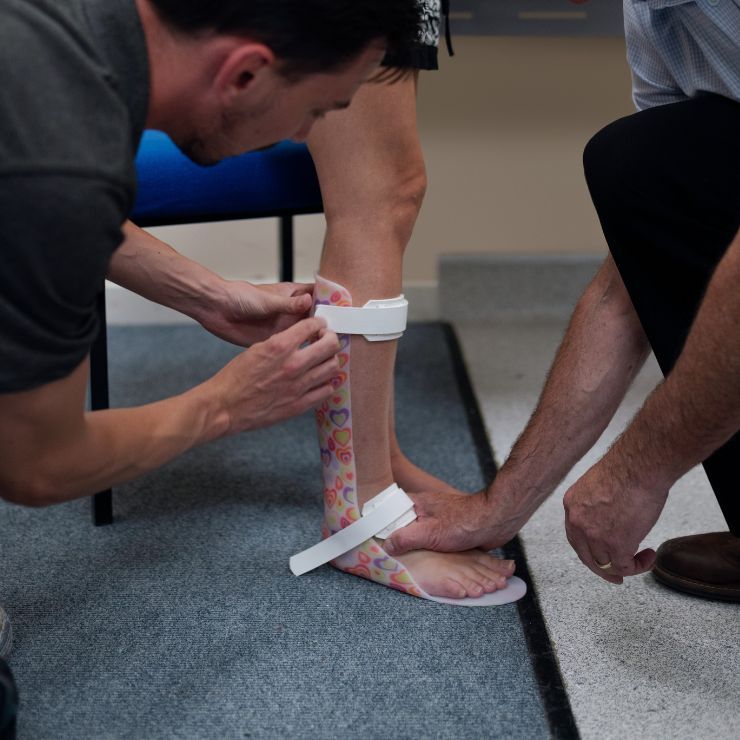Function - not Fashion!
We BOTH wore walking boots – not much fun!
My husband and I both had to wear walking boots! I wore one for a couple of months after major ankle surgery – not much fun in the summer in hot and humid Houston, Texas! He wore one for a couple of days after breaking his toes!
First, I am not a doctor or in the medical field. This article is meant to provide food for thought and to bring questions to your mind for you to ask your doctor. This information is based on my personal information and research.
What is the Purpose of a Walking Boot?
If you have injured your ankle, you may be wondering when to wear a walking boot. A walking boot is often prescribed after an ankle sprain to provide stability and protect the ankle from further injury. In this article, we will discuss the purpose of a walking boot and when it should be worn. We will also provide tips for safely using a walking boot.
A walking boot is designed to stabilize the foot and ankle following an injury. The boot immobilizes the foot and protects it from further injury. A walking boot may also be known as a CAM walker, Ankle Stirrup, or Moon Boot.
A walking boot should be worn as directed by your doctor. Most people wear a walking boot for 6-8 weeks. You may need to wear the boot for longer if you have a more serious injury. Your doctor will let you know how long you need to wear the boot.
Follow Your Doctor’s Instructions!
It is important to follow your doctor's instructions for wearing the boot. The boot should be worn as much as possible, except when you are showering or sleeping.
You may need to use crutches when wearing the boot. This is to keep weight off of the injured ankle.
If you have any pain, swelling, or redness in your foot or ankle, please contact your doctor. These could be signs that you are wearing the boot too much or that you have developed a new injury.
Wearing a walking boot is an important part of recovering from an ankle injury. However, it is important to follow your doctor's instructions and to watch for any new pain or swelling. With proper care, you will be able to heal properly and reduce your risk of re-injury.
How to Make your Walking Boot Look More Stylish!
They are made to help you heal. If you don't like the clumpy design, add a few stickers, paint on some racing stripes, or color coordinate with your attire by adding a small bow!
What Type of a Shoe Should you Wear on the Non-Boot Foot?
No matter which shoe you select, you can always spice it up! Turn your drab walking boot into bling! Also, wear an eye-catchy shoe of your other foot.
When you have an injury that requires wearing a walking boot, you may be wondering what type of shoes to wear with it. The good news is that there are many options available, and you can choose the style that best suits your needs.
One option is to wear a regular sneaker over your boot. This can provide additional support and cushioning, and it can also help to keep your foot warm in cold weather.
Another option is to wear a sandal with your boot. This can be a good choice if you live in a warm climate or if you're looking for a more breathable option. Whichever style you choose, make sure that your shoes are comfortable and provide good support. Remember, your walking boot is made of hard material and is heavy. One misplacement of your boot, on top of your sandaled or naked foot, could cause much pain and discomfort for the unprotected foot. Think twice about walking around barefoot or in sandals.
I also recommend that you wear a shoe that has a heel height similar to the same height as your booted foot. That way you are walking more evenly balanced and not swaying from side to side, which could cause other injuries to your back or hips.
When you are walking in your boot, pay close attention to your body. How do you feel? How does your back, neck, the other leg, etc. feel? Take your time! This is no time to be in a foot race or carrying more than you could handle on a normal day. Give yourself time to heal and to pamper yourself! You will have plenty of time in the future to wear your favorite shoes, chase after the kids or take those long afternoon shopping sprees!
What are the Best Shoes to Wear After a Walking Boot?
Depending on what your doctor or physical therapist prescribes, you may be able to ditch the walking boot and replace it with a regular shoe.
Resuming regular activities can help prevent stiffness and the feeling that your foot has "fallen asleep."
To protect your foot while it heals, you'll want to select shoes with good arch support and cushioning. Look for a pair with a rocker bottom — this design element helps reduce stress on the front of your foot as you walk.
In general, tennis shoes or running shoes are best, followed by walking shoes, as they provide good support without being too rigid.
You'll also want to make sure there's enough room in the toe box — your toes shouldn't feel cramped when you're wearing the shoe.
And finally, I know you will be tempted to want to get back into fashion, but you should avoid high heels, as they can put undue pressure on your injured foot. Depending on the height of the heel, your ankle may not be strong enough to manage a high heel and you may twist your ankle and fall – which could put you back at the doctor’s office. Take time to heal! Take time for YOU!
How to Get Back to Normal Life!
Take your time, ease back into normal life. Your injured ankle / foot may take time to regain its strength and coordination.
Pay close attention to walking up and down stairs or curbs with the boot on and after you have been released from the boot. Your mind may not be synced with your foot and you may fall or stub your toe.
Final words, take your time, do as the doctor says, follow the orders of your physical therapist – do not over do it!
Good luck!
Annie
AnniesAnswers.com
If you would like more information, I recently wrote the following articles regarding life with and after a walking boot, titled:










